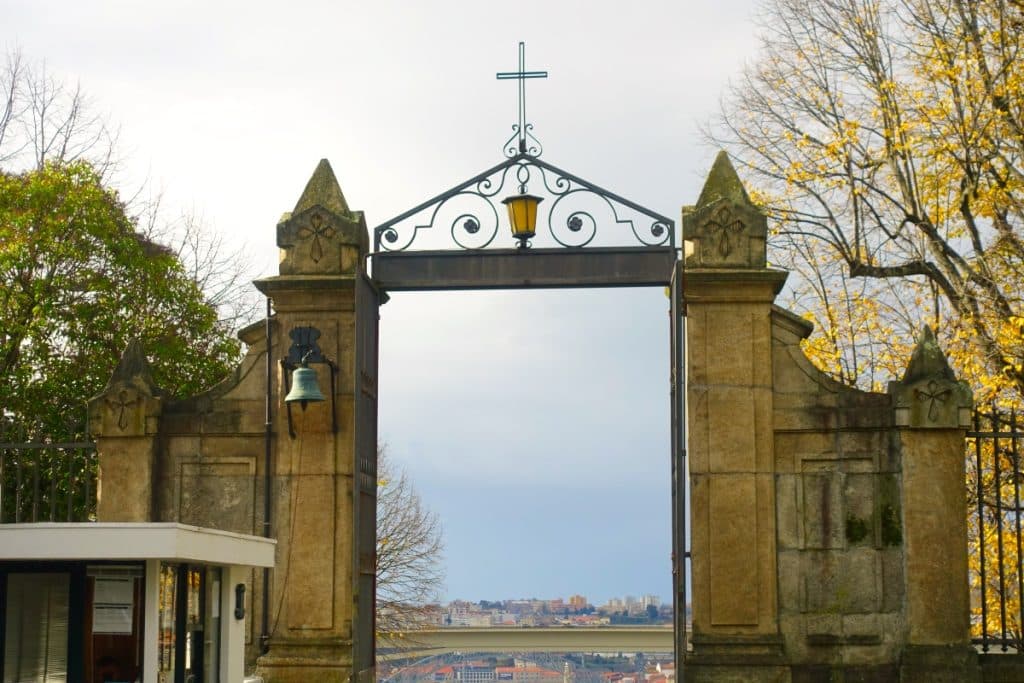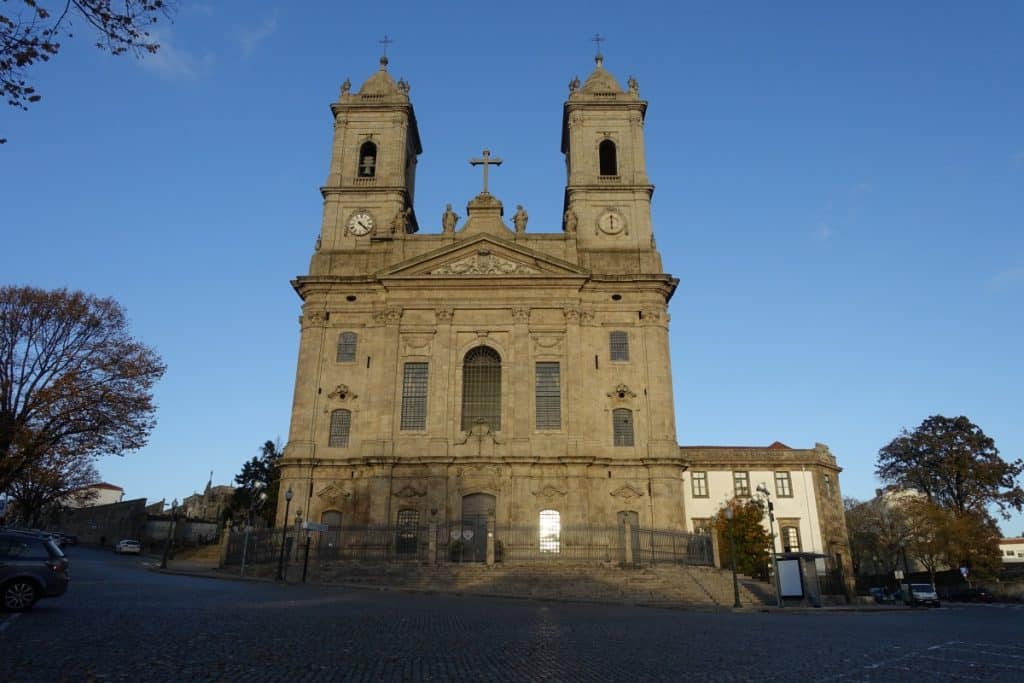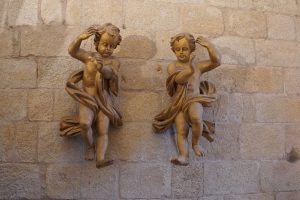The picturesque city of Porto, famous for its winding streets, historic buildings and unmistakable port wine. It also holds lesser-known treasures hidden deep within its soil: the cemeteries in Porto.
These sacred sites are not only final resting places, but also silent chronicles of the city’s history, telling stories of love, loss, triumph and tragedy.
We visited two of the most impressive cemeteries in Porto and discovered how different and unique the burial culture of the countries in Europe is. Even how different cemeteries can be in one city.
Cemitério Prado do Repouso
One of the largest cemeteries in Porto is the Cemitério Prado do Repouso. It was Porto’s first public cemetery.
In 1804, a bishop founded a diocesan seminary on the site of the current cemetery and had a chapel built. This chapel, which was dedicated to St. Victor, is the current cemetery chapel. During the Liberal Wars (1832 and 1834), the clergy left the site and many of the buildings burned down.

Until 1835, funerals in Portugal were held in churches and in their immediate vicinity. This was a centuries-old tradition that was closely linked to the Catholic Church. However, these practices often led to hygiene problems, especially in densely populated urban areas.
Reform of the burial culture in Porto
In 1835, the Portuguese government, under the leadership of Passos Manuel, introduced a series of reforms known as the “Reforms of 1835”. One of these reforms concerned burial practices in Porto’s cemeteries. The government banned burials in churches and private cemeteries. The regulation stipulated that burials should only take place outside the city limits. This was an attempt to improve public health and prevent the spread of diseases caused by the accumulation of corpses in churches and their immediate vicinity.

The reforms of 1835 were controversial and met with resistance from the Catholic Church and many traditional groups in the country. Nevertheless, they marked an important step towards the modernization and secularization of the Portuguese state.
The site of today’s cemetery was outside the city limits at the time, was already walled and was a suitable location. The city council authorized public works to adapt the site through earthworks. The church of St. Victor was integrated into the area designated for the cemetery and renamed the chapel of the Prado do Repouso cemetery.

Impressions of a tour
At 10 hectares, the grounds are very large. Wide paths form the main axes that connect the different areas of the cemetery. In addition to the public areas, the private cemeteries of the Santa Casa da Misericórdia do Porto, the Ordem do Terço and the Confraria do Santíssimo Sacramento de Santo Ildefonso are also located on the grounds.
If you are familiar with Portuguese history, art and culture, you will discover the graves of numerous famous Portuguese politicians, actors, academics and aristocrats. Unfortunately, we don’t know our way around and were only able to discover the occasional “celebrity grave” with the help of a few information boards.

But to be honest, the graves of famous people tend to take a back seat in this cemetery. There are beautiful neo-Gothic crypts made of marble and granite, unique sculptures and lovingly designed details adorn some of the graves. In some areas, the cemetery has a structured layout, while in other areas the graves are close together and almost form a small town.
As we strolled through the rows of graves, we also discovered two memorials on the grounds.

Monumento aos Portuenses Inumados no Prado do Repouso
The “Monumento aos Portuenses Inumados no Prado do Repouso” is a monument in Porto, Portugal, dedicated to the citizens of Porto who are buried in the “Prado do Repouso” cemetery.
Monumento aos Vencidos da Revolta de 31 de Janeiro
The “Monumento aos Vencidos da Revolta de 31 de Janeiro” (Monument to the Defeated of the January 31st Uprising) in Porto is a monument commemorating those who fought and were defeated by the monarchist government of Portugal during the Republican Uprising of 1891. The uprising of January 31, 1891 was the first serious attempt to overthrow the monarchy in Portugal and establish a republic. Although this uprising failed, it laid the foundations for the later republican movement, which ultimately led to the founding of the First Portuguese Republic in 1910.
The monument shows a mourning figure representing the city of Porto and commemorates those who lost their lives in the uprising. It is an expression of mourning and respect for those who fought for their beliefs. It was designed by the Portuguese sculptor Henrique Moreira. Henrique Moreira was a well-known sculptor in Portugal and his works can be found in various places in Porto and throughout the country.

Address:
Largo de Soares dos Reis,
4300-096 Porto, Portugal
Cemitério da Lapa
The Lapa district is one of the least touristy areas in Porto. The highlight of the area is definitely the Igreja da Lapa with the cemetery next to it.
A look inside the Igreja da Lapa
In 1754, D. Diogo de Sousa, the Governor of Arms of Porto, invited Father Ângelo Sequeira, the founder of the Venerable Confraternity of Our Lady of Lapa, to visit the city. Inspired by his visit, Father Sequeira decided to build a chapel in honor of Our Lady of Lapa. In 1755, this chapel was built in a secluded spot in the “Padrão velho”, located at the foot of the S. Ovídio hill.

In view of the growing interest of the community, the foundation stone for a larger church was laid on July 17 of the following year. The construction of this church lasted until 1863, and the solemn consecration of the church took place on May 1, 1779.
The church stands on a small square, from which steps lead up to the entrance. The façade of the church is in a neoclassical style, which became popular in Portugal in the second half of the 18th century. It is characterized by its symmetrical structure and the use of columns flanking the main entrance.

On the outer façade are four female statues that are taller than a person and represent four women from the Old Testament: Rachel, Judith, Esther and Sarah. From the outside, I think the church looks very monotonous. That changes when you enter the nave.

The church of Lapa, a veritable museum in itself, houses numerous works of art and relics. Inside, the main altar stands out, a masterpiece by the carver Manuel Moreira da Silva from Porto, complemented by a painting by Joaquim Rafael. Another highlight is the miniature nativity scene, a legacy of the Machado de Castro school, and the simulacrum of the relic of St. Victoria. The stained glass windows give the interior a special atmosphere.

In the chancel there is a granite mausoleum with the heart of King Pedro IV, King of Portugal and also known as Pedro I Emperor of Brazil. He chose the Igreja da Lapa as the final resting place for his heart as a sign of his affection for the city of Porto.
Cemeteries in Porto: Lapa cemetery
Right next to the church, the path to the cemetery leads through a large gate. I have to admit that I was a little confused when I saw a guard walking between the graves. However, it later turned out that this measure made perfect sense. I saw quite a few graves that had been broken into and the coffins destroyed. What could make people do something like that?

In 1833, Porto was besieged and cholera subsequently broke out in the city. The existing cemeteries in Porto were quickly overcrowded. So the Venerable Confraternity of Nossa Senhora da Lapa asked King Pedro IV for permission to open a private cemetery next to their church.

Today, the cemetery is considered to be the oldest Portuguese cemetery built in Porto during the Romantic period. A characteristic of cemeteries from this era: they were not only burial sites, but also places to walk and meditate. I find the cemetery “too small” for walking. But the peace and quiet to meditate, reflect and calm down is definitely here.

Due to the hillside location, the grounds are divided into different levels, which are connected by stairs. On my tour, I discover chapels and tombs built by the bourgeoisie of Porto. This “Gallery of the Illustrious” also displays some of the most famous works of art from the Romantic period, from architecture and sculpture to iron and ceramics. Important personalities of the city, including the writer Camilo Castelo Branco, the architect Marques da Silva and the artist Armanda Passos have found their final resting place here.

Many of the tombs are surprisingly well preserved, others look dilapidated and some have even been deliberately damaged. When I look into one of the open doors of a burial chapel, I shudder a little at the thought of being there alone. The gravestones lie broken on the ground and the scene reminds me a little of a bad horror movie…
If you want to see one of the most beautiful cemeteries in Porto, the cemetery in Lapa is definitely the right place. I enjoyed strolling around here and discovering one or two sculptures.

Address:
Largo da Lapa 1,
4050-000 Porto, Portugal



















Leave a Reply